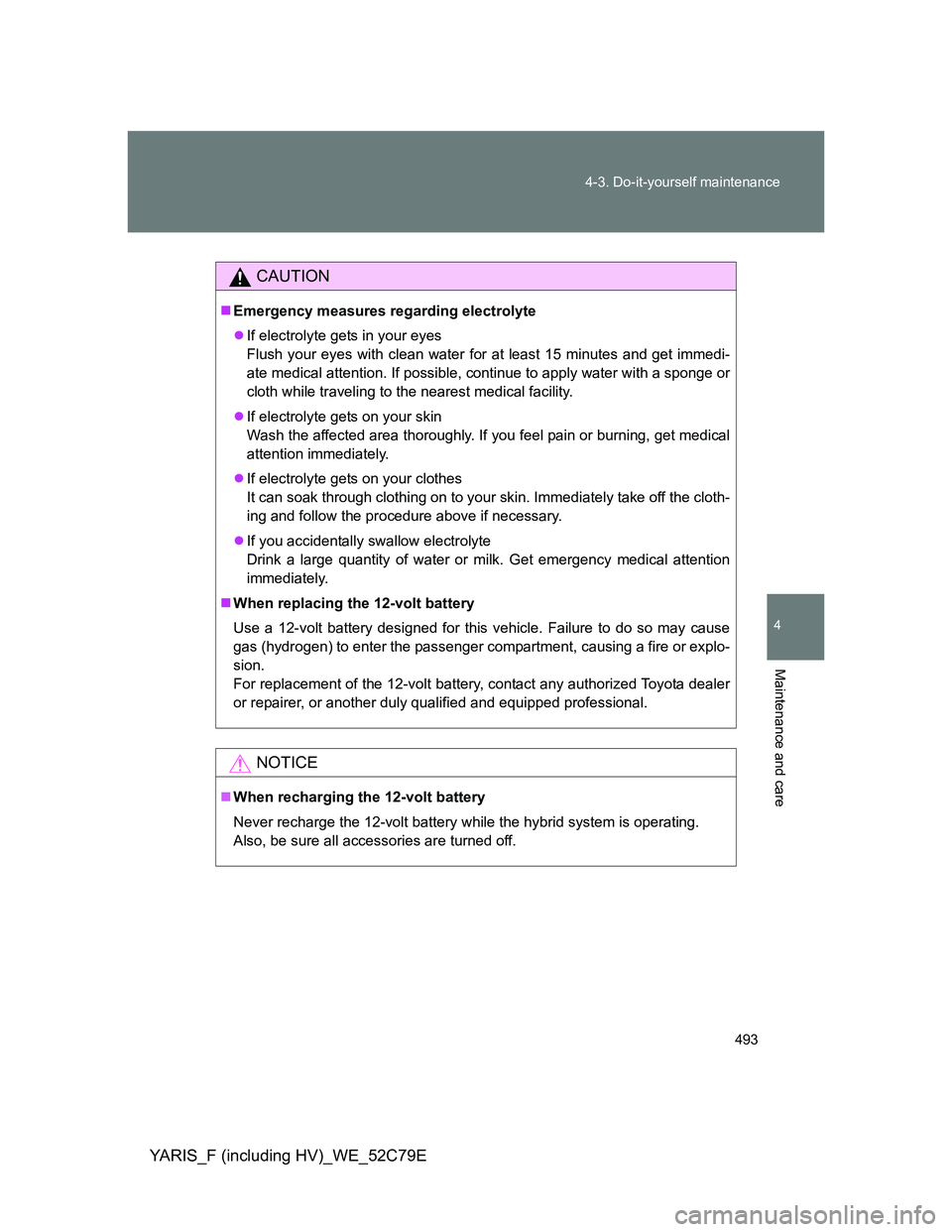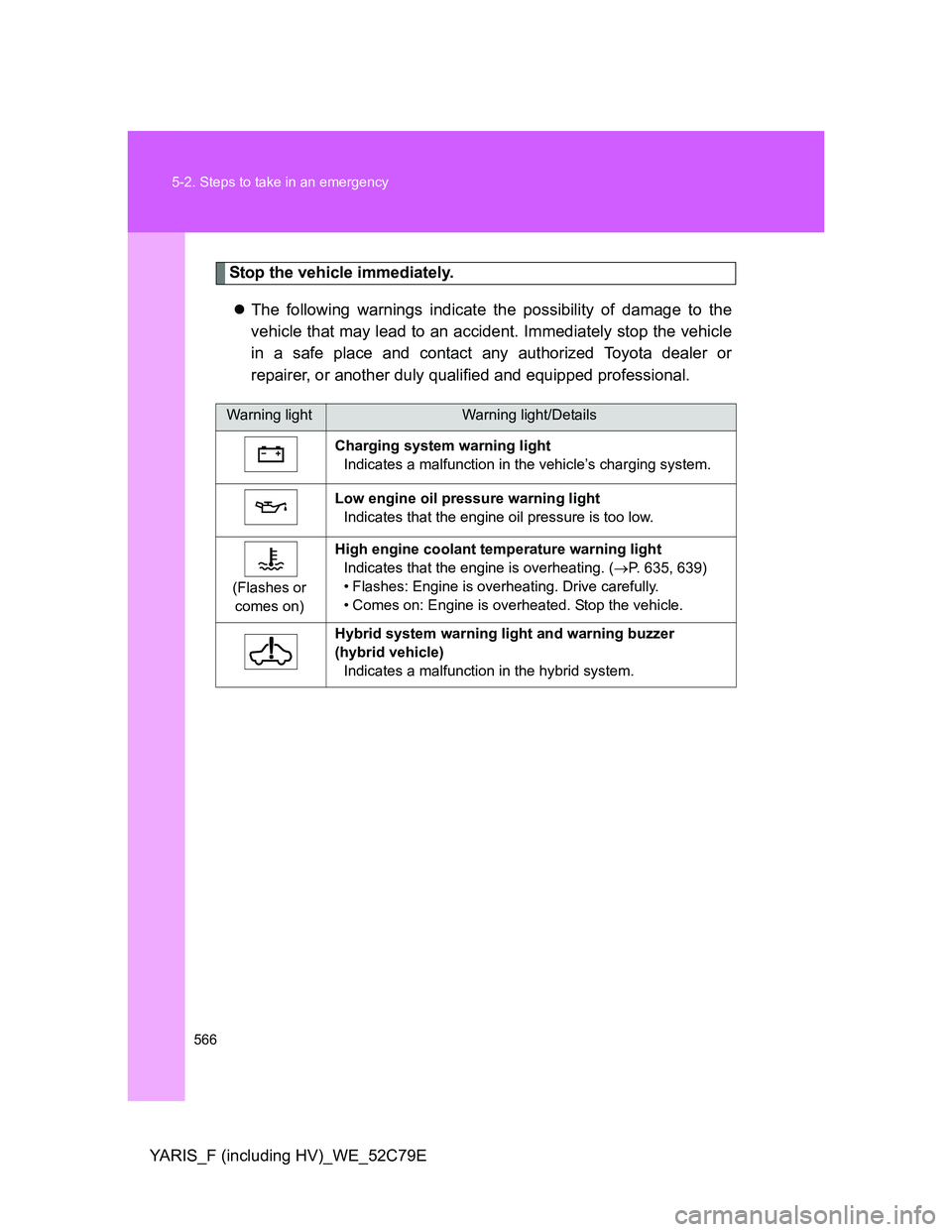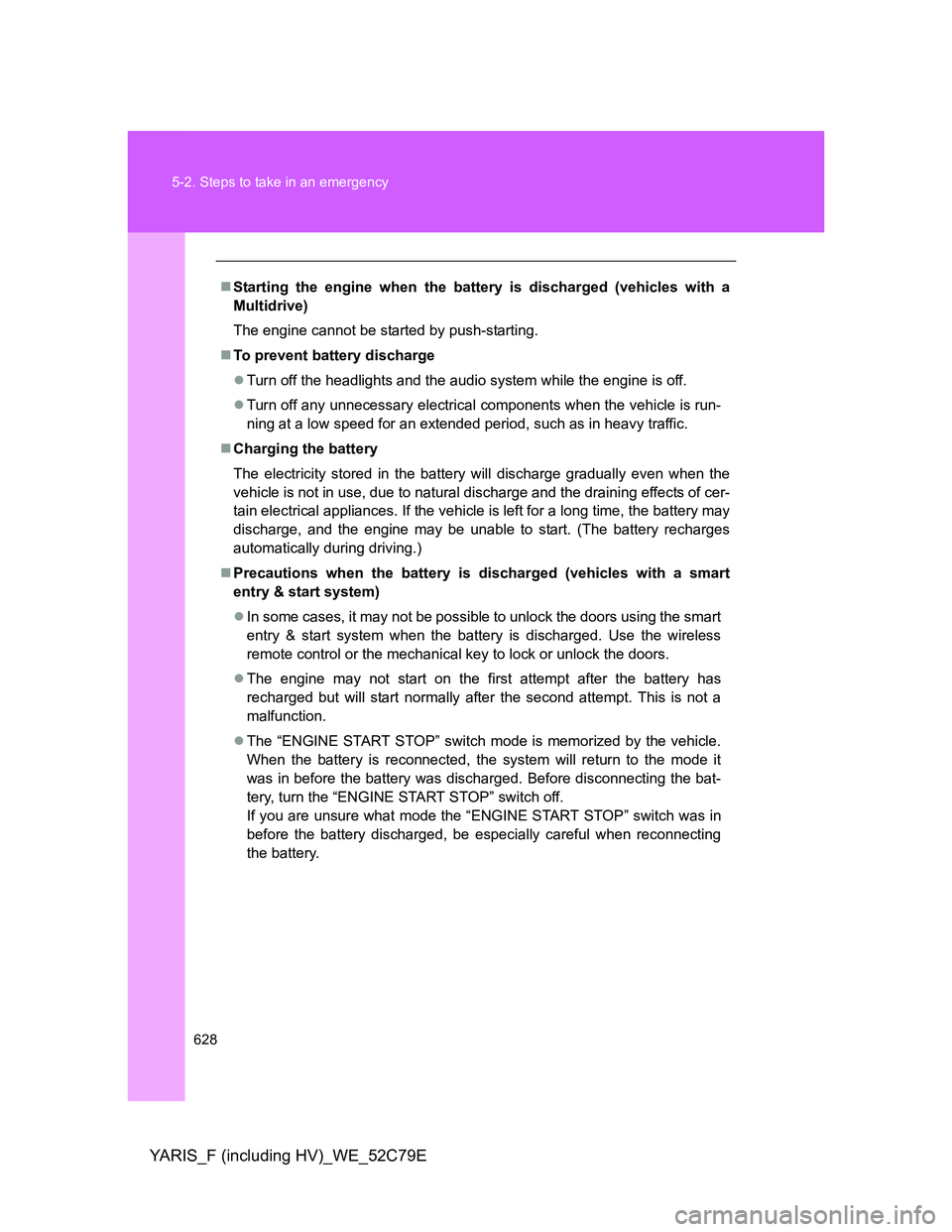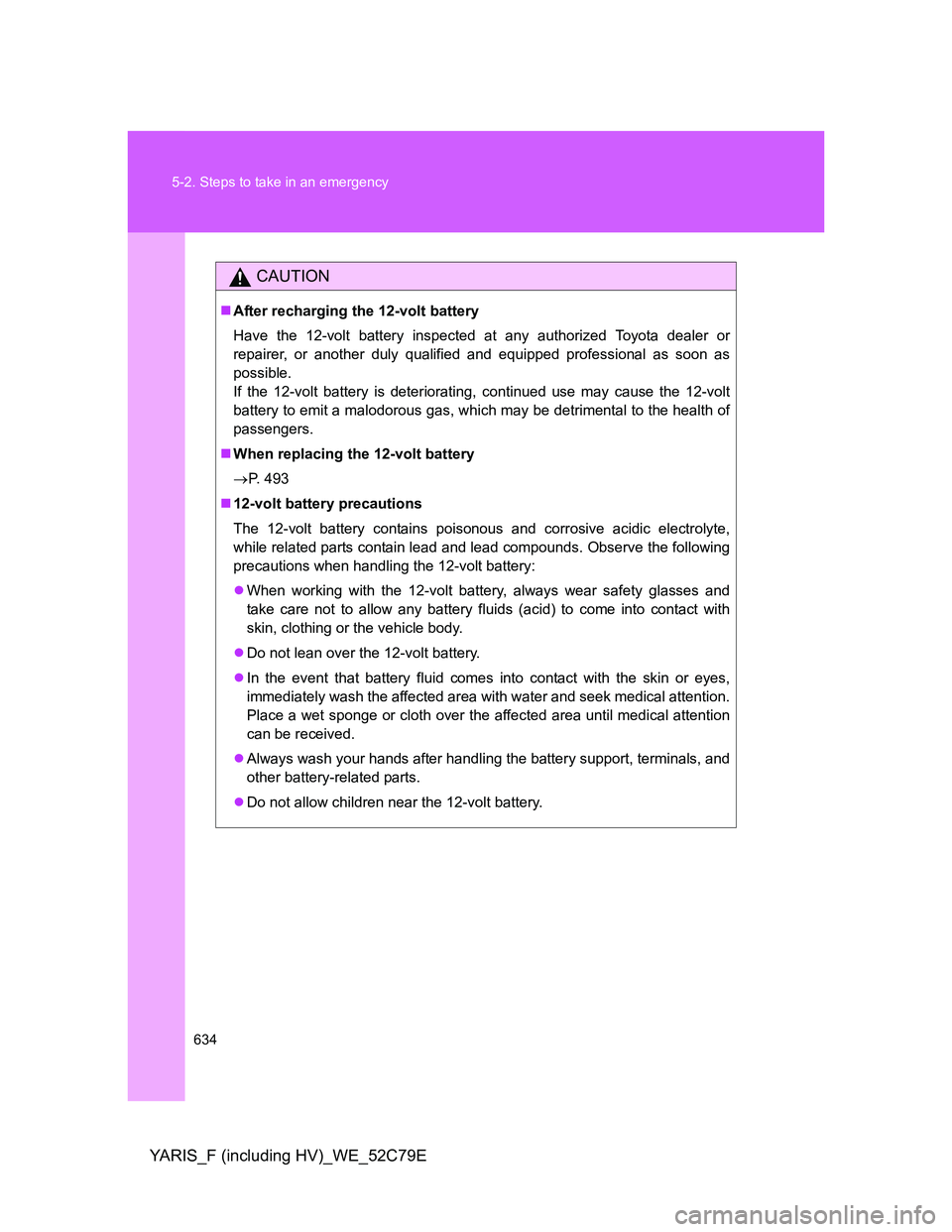2012 TOYOTA YARIS HYBRID charging
[x] Cancel search: chargingPage 491 of 704

491 4-3. Do-it-yourself maintenance
4
Maintenance and care
YARIS_F (including HV)_WE_52C79E
Before recharging
When recharging, the 12-volt battery produces hydrogen gas which is flam-
mable and explosive. Therefore, observe the following precautions before
recharging:
If recharging with the 12-volt battery installed on the vehicle, be sure to
disconnect the ground cable.
Make sure the power switch on the charger is off when connecting and
disconnecting the charger cables to the 12-volt battery.
When disconnecting the 12-volt battery terminals
Always disconnect the negative (-) terminal first.
After recharging/reconnecting the 12-volt battery
Unlocking the doors using the smart entry & start system may not be
possible immediately after reconnecting the 12-volt battery. If this hap-
pens, use the wireless remote control or the mechanical key to lock/
unlock the doors.
Vehicles with an electronic key: Start the hybrid system with the
“POWER” switch in ACCESSORY mode. The hybrid system may not
start with the “POWER” switch turned off. However, the hybrid system will
operate normally from the second attempt.
Caution symbols
The meanings of each caution symbol on the top of the battery are
as follows:
No smoking, no naked
flames, no sparksBattery acid
Shield eyesNote operating
instructions
Keep away from childrenExplosive gas
Page 493 of 704

493 4-3. Do-it-yourself maintenance
4
Maintenance and care
YARIS_F (including HV)_WE_52C79E
CAUTION
Emergency measures regarding electrolyte
If electrolyte gets in your eyes
Flush your eyes with clean water for at least 15 minutes and get immedi-
ate medical attention. If possible, continue to apply water with a sponge or
cloth while traveling to the nearest medical facility.
If electrolyte gets on your skin
Wash the affected area thoroughly. If you feel pain or burning, get medical
attention immediately.
If electrolyte gets on your clothes
It can soak through clothing on to your skin. Immediately take off the cloth-
ing and follow the procedure above if necessary.
If you accidentally swallow electrolyte
Drink a large quantity of water or milk. Get emergency medical attention
immediately.
When replacing the 12-volt battery
Use a 12-volt battery designed for this vehicle. Failure to do so may cause
gas (hydrogen) to enter the passenger compartment, causing a fire or explo-
sion.
For replacement of the 12-volt battery, contact any authorized Toyota dealer
or repairer, or another duly qualified and equipped professional.
NOTICE
When recharging the 12-volt battery
Never recharge the 12-volt battery while the hybrid system is operating.
Also, be sure all accessories are turned off.
Page 566 of 704

566 5-2. Steps to take in an emergency
YARIS_F (including HV)_WE_52C79E
Stop the vehicle immediately.
The following warnings indicate the possibility of damage to the
vehicle that may lead to an accident. Immediately stop the vehicle
in a safe place and contact any authorized Toyota dealer or
repairer, or another duly qualified and equipped professional.
Warning lightWarning light/Details
Charging system warning light
Indicates a malfunction in the vehicle’s charging system.
Low engine oil pressure warning light
Indicates that the engine oil pressure is too low.
(Flashes or
comes on)High engine coolant temperature warning light
Indicates that the engine is overheating. (P. 635, 639)
• Flashes: Engine is overheating. Drive carefully.
• Comes on: Engine is overheated. Stop the vehicle.
Hybrid system warning light and warning buzzer
(hybrid vehicle)
Indicates a malfunction in the hybrid system.
Page 628 of 704

628 5-2. Steps to take in an emergency
YARIS_F (including HV)_WE_52C79E
Starting the engine when the battery is discharged (vehicles with a
Multidrive)
The engine cannot be started by push-starting.
To prevent battery discharge
Turn off the headlights and the audio system while the engine is off.
Turn off any unnecessary electrical components when the vehicle is run-
ning at a low speed for an extended period, such as in heavy traffic.
Charging the battery
The electricity stored in the battery will discharge gradually even when the
vehicle is not in use, due to natural discharge and the draining effects of cer-
tain electrical appliances. If the vehicle is left for a long time, the battery may
discharge, and the engine may be unable to start. (The battery recharges
automatically during driving.)
Precautions when the battery is discharged (vehicles with a smart
entry & start system)
In some cases, it may not be possible to unlock the doors using the smart
entry & start system when the battery is discharged. Use the wireless
remote control or the mechanical key to lock or unlock the doors.
The engine may not start on the first attempt after the battery has
recharged but will start normally after the second attempt. This is not a
malfunction.
The “ENGINE START STOP” switch mode is memorized by the vehicle.
When the battery is reconnected, the system will return to the mode it
was in before the battery was discharged. Before disconnecting the bat-
tery, turn the “ENGINE START STOP” switch off.
If you are unsure what mode the “ENGINE START STOP” switch was in
before the battery discharged, be especially careful when reconnecting
the battery.
Page 633 of 704

5
633 5-2. Steps to take in an emergency
When trouble arises
YARIS_F (including HV)_WE_52C79E
The hybrid system may not start on the first attempt after the 12-volt bat-
tery has recharged but will start normally after the second attempt. This is
not a malfunction.
Vehicles with an electronic key: The “POWER” switch mode is memo-
rized by the vehicle. When the 12-volt battery is reconnected, the system
will return to the mode it was in before the 12-volt battery was dis-
charged. Before disconnecting the 12-volt battery, turn the “POWER”
switch off.
If the “POWER” switch was in ACCESSORY or ON mode before the 12-
volt battery was discharged, the audio system and/or air conditioning
system may operate when the 12-volt battery is reconnected.
Charging the 12-volt battery
The electricity stored in the 12-volt battery will discharge gradually even
when the vehicle is not in use, due to natural discharge and the draining
effects of certain electrical appliances. If the vehicle is left for a long time, the
12-volt battery may discharge, and the hybrid system may be unable to start.
(The 12-volt battery recharges automatically while the hybrid system is oper-
ating.)
CAUTION
Avoiding 12-volt battery fires or explosions
Observe the following precautions to prevent accidentally igniting the flam-
mable gas that may be emitted from the 12-volt battery:
Make sure each jumper cable is connected to the correct terminal and that
it is not unintentionally in contact with anything other than the intended ter-
minal.
Do not allow the other end of the jumper cable connected to the “+” termi-
nal to come into contact with any other parts or metal surfaces in the area,
such as brackets or unpainted metal.
Do not allow the + and - clamps of the jumper cables to come into contact
with each other.
Do not smoke, use matches, cigarette lighters or allow open flame near
the 12-volt battery.
Page 634 of 704

634 5-2. Steps to take in an emergency
YARIS_F (including HV)_WE_52C79E
CAUTION
After recharging the 12-volt battery
Have the 12-volt battery inspected at any authorized Toyota dealer or
repairer, or another duly qualified and equipped professional as soon as
possible.
If the 12-volt battery is deteriorating, continued use may cause the 12-volt
battery to emit a malodorous gas, which may be detrimental to the health of
passengers.
When replacing the 12-volt battery
P. 493
12-volt battery precautions
The 12-volt battery contains poisonous and corrosive acidic electrolyte,
while related parts contain lead and lead compounds. Observe the following
precautions when handling the 12-volt battery:
When working with the 12-volt battery, always wear safety glasses and
take care not to allow any battery fluids (acid) to come into contact with
skin, clothing or the vehicle body.
Do not lean over the 12-volt battery.
In the event that battery fluid comes into contact with the skin or eyes,
immediately wash the affected area with water and seek medical attention.
Place a wet sponge or cloth over the affected area until medical attention
can be received.
Always wash your hands after handling the battery support, terminals, and
other battery-related parts.
Do not allow children near the 12-volt battery.
Page 668 of 704

668 6-1. Specifications
YARIS_F (including HV)_WE_52C79E
Ignition system (gasoline engine only)
Electrical system
Spark plug
Make
Gap1KR-FE engine
DENSO SK16HR11
1NR-FE engine
DENSO SC20HR11
1NZ-FXE engine
DENSO FK16R-A8
1KR-FE and 1NR-FE engines
1.1 mm (0.043 in.)
1NZ-FXE engine
0.8 mm (0.031 in.)
NOTICE
Iridium-tipped spark plugs
Use only iridium-tipped spark plugs. Do not adjust the spark plug gap.
Battery (except hybrid vehicle)/
12-volt battery (hybrid vehicle)
Open voltage* at
20C (68F):12.6 12.8 V Fully charged
12.2 12.4 V Half charged
11 . 8 12.0 V Discharged
(
*: Voltage checked 20 minutes after
the engine and all the lights turned
off)
Charging rates 5 A max.
Page 696 of 704

696 Alphabetical index
YARIS_F (including HV)_WE_52C79E
Tachometer .............................. 273
Tail lights
Replacing light bulbs ............. 535
Switch ................................... 293
Wattage................................. 677
Telephone switch*
Theft deterrent system
Double locking system .......... 162
Engine immobilizer system ... 155
Immobilizer system ............... 155
Tire inflation pressure ............. 498
Tires
Chains ................................... 338
Checking ............................... 494
If you have a flat tire...... 582, 594
Inflation pressure .......... 498, 672
Replacing .............................. 582
Rotating tires ......................... 494
Size ....................................... 672
Snow tires ............................. 338
Spare tire .............................. 582
Tools ................................. 582, 595
Total load capacity .................. 654
Towing
Emergency towing ................ 554
Trailer towing ................ 342, 343
Traction control ....................... 326
Transmission shift
switches ......................... 261, 262
TRC ........................................... 326
Trip information ....................... 286
Trip meter ................................. 273
Turn signal lights
Replacing light bulbs ............. 535
Switch ................................... 269
Wattage................................. 677Vanity lights
Vanity lights .......................... 426
Wattage ................................ 677
Vanity mirrors .......................... 426
Vehicle identification
number ................................... 656
Vehicle stability control .......... 326
VSC ........................................... 326
Warning buzzers
Brake system ........................ 565
Clutch.................................... 566
Electric power steering
system ................................ 568
Hybrid system ....................... 566
Hybrid system overheat ........ 570
Multi-mode manual
transmission ....................... 566
P position request
indicator light ...................... 570
Seat belt reminder ................ 570
Warning lights
Anti-lock brake system.......... 568
Brake assist system .............. 568
Brake system ........................ 565
Charging system ................... 566
Clutch.................................... 566
Cruise control indicator
light ..................................... 568
DPF system .......................... 570
Electric power steering ......... 568
Electronic engine control
system ................................ 568
Engine oil maintenance ........ 570
Fuel filter ............................... 568
High engine coolant
temperature ........................ 566
Hybrid system ....................... 566
Hybrid system overheat ........ 570
Low engine oil level .............. 570
Low engine oil pressure ........ 566TV
W